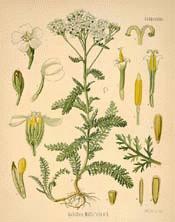Y is for Yarrow
I'm interested in herbal plants and remedies. I'm not fond of the modern take a pill for everything.
I knew Yarrow had medicinal qualities so I looked it up to share.
Poo poo the idea of herbal remedies? Where to you think modern pharmaceuticals get their ideas? Many of the modern remedies had their roots from herbs.
Yarrow is a flowering perennial, common in North America but also native to Europe and Asia. Its leaves are soft and highly segmented with a characteristic appearance that is almost feather-like. Yarrow grows stalks during the summer months, with a height that is dependent upon the seasonal rainfall. During dry years, these stalks may only grow a foot or two, preserving energy in its roots. Clusters of tiny white flowers grow atop the stalks, emitting a distinctive and characteristic aroma.
Yarrow received its Latin name Achillea from the legendary Greek hero Achilles. According to the common legend, Achilles’s mother dipped him into the river Styx by the ankle in an effort to make him invulnerable. Fighting many battles as a seemingly invincible warrior, Achilles used yarrow to treat the wounds of his fellow soldiers. He later died from a wound to his heel, as it was the one unprotected part of his anatomy.
Benefits of Yarrow:
Yarrow is helpful in relieving fevers, shortening the duration of cold and flu, helping improve relaxation during illness, and relieving cramps associated with hormones or illness. Applied topically, it is helpful with skin itching, rash or other issues.An external tincture or poultice will often help with hemorrhoids, rashes and broken skin. Some people will notice relief from allergy symptoms by drinking a tea of yarrow and mint.
A Modern Herbal by Mrs. M. Grieve:
Yarrow is a diaphoretic, astringent, tonic, stimulant and mild aromatic.
Yarrow Tea is a good remedy for severe colds, being most useful in the commencement of fevers, and in cases of obstructed perspiration. The infusion is made with 1 OZ. of dried herb to 1 pint of boiling water, drunk warm, in wineglassful doses. It may be sweetened with sugar, honey or treacle, adding a little Cayenne Pepper, and to each dose a teaspoonful of Composition Essence. It opens the pores freely and purifies the blood, and is recommended in the early stages of children's colds, and in measles and other eruptive diseases.
A decoction of the whole plant is employed for bleeding piles, and is good for kidney disorders. It has the reputation also of being a preventative of baldness, if the head be washed with it.
If for some reason, man made medicine can no longer be manufactured, the need to know about herbal remedies will skyrocket. Be prepared. Have a book on herbs readily available in your supplies. It could be the difference between life and death. Or the difference between a bland meal and one seasoned to melt in your mouth.
I can't remember which one I have. It is one of two. I'm not sure where I put mine, possibly in the kitchen with my cook books!
http://www.amazon.com/Complete-Medicinal-Herbal-Practical-Properties/dp/156458187X/
or this one
http://www.amazon.com/Illustrated-Guide-Herbal-Home-Remedies/dp/0754818578/
www.beverlyovalle.com


No comments:
Post a Comment